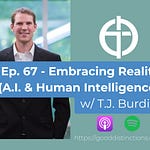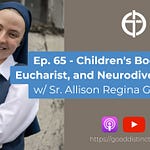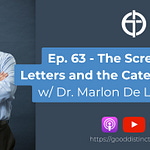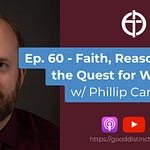NOTE: THIS EPISODE WAS PUBLISHED BEFORE OUR REBOOT. willwrightcatholic.com is now gooddistinctions.com
A Subversion of Expectations
There is a well-known quote from the 1995 movie Usual Suspects. Perhaps you’ve heard it: “The greatest trick the Devil ever pulled was convincing the world he didn’t exist.” Isn’t this true? And we could take it a step further to say that Satan has not created anything at all in his entire existence. He just subverts good things created by God. Satanism, even, is nothing more than a hollow reversal of the truth, goodness, and beauty of Christianity.
If I showed you an upside down cross, what would you think of it? Would you immediately recoil and say that it’s satanic? Today, that might be the expectation. But what if I told you that the upside down cross is the Cross of St. Peter who did not believe himself to be worthy of crucifixion in the same manner as Jesus. It wasn’t made a satanic symbol until the 18th Century.
What about the five-pointed star enclosed in a circle? This is universally recognized as a satanic symbol. The so-called church of Satan and the Satanic Temple have taken it on as their symbol. However, the pentagram (and pentacle) is traditionally associated with both the five senses of the human body and also with the five Wounds of Christ! The hermeticists of the Renaissance period hijacked it and made it an image of magic. And it wasn’t made a satanic symbol until the 1960s.
These are just a couple of examples to show that we need to reexamine our preconceived notions from time to time.
What is All Saints’ Day?
The liturgical calendar of the Church is punctuated by various feast days of saints. On these days, we ask in a special way for the intercession of these holy men and women. We also honor their cooperation with God’s grace and seek to imitate their lives. We may also read some of their writings or pray in a way which was particularly loved by that saint.
There are too many saints to honor specifically by name and there are only 365 days in a year, and we do not know the names of all the citizens of Heaven. So, the Church celebrates All Saints’ Day each year to commemorate each individual in Heaven: those known by name and those known to God alone.
All Saints’ Day is celebrated each year on November 1st and is a Holy Day of Obligation for Catholics of the Latin Rite. In the Eastern Catholic Churches, this special feast is celebrated on the Sunday after Pentecost. In the Latin West, November 1 became the date to honor all saints. This practice goes back at least to the 8th Century. Even in secular culture, we have an indication of the prevalence of the day. The night before All Saints’ Day is known as All Hallows’ Eve or Halloween (Hallow is the German word for the Latin sanctus).
Halloween is Definitely Part of American Culture
As a secular celebration, Halloween is a huge deal in the United States. Kids go trick-or-treating, we watch scary movies, people dress up in costumes, go to haunted houses and corn mazes, tell spooky stories, and listen to scary music. To be honest, it was always one of my favorite secular celebrations as a kid. What kid would not want a bag full of free candy? As a teenager, I didn’t trick-or-treat, but I still went to theme parks during Halloween time and went through the haunted walk-through attractions. And as an adult I would go on haunted walking tours in old cities; I’m pretty sure I could lead the French Quarter ghost walking tour in New Orleans.
Death is Part of Our Fallen Reality
We have to keep in mind that death is part of our fallen reality. Humanity has always had a fascination with the macabre and things that go bump in the night. Why this interest in the ethereal and otherworldly? What is it about this day, in particular, that draws out the attention to the supernatural or paranormal?
Death comes to all, much like taxes. The answer is what are we going to do about it? We can run from it, but it will chase us to the tune of the ticking of the clock. Human beings are no stranger to death, but that plan was not so from the beginning. Our first parents were created in a state of original justice, walking hand in hand, so to speak, with God. After the first sin, evil entered the world. Our nature was tainted by the inclination to do wrong and offend God. Our relationship with Him was changed. And death entered our reality.
However, God did not leave us abandoned to our sin. In fact, death itself was both punishment and salvation. Anyone who has watched a vampire movie knows the curse of immortal life in this vale of tears. And those who watch zombie movies see bodies without souls and ghost movies show us souls without bodies. Again, all these examples show the futility of being trapped in the earthly realm of suffering.
Our relationship with death is complicated. We rightly grieve when a loved one dies, and we naturally have an aversion to the thought of our own death. Sometimes, in despair, we might have suicidal ideation due to a traumatic event or mental illness. Think of the fictional character Hamlet weighing this earthly life of suffering and the endless sleep of death: “To be, or not to be, that is the question…” Hamlet is even pictured in the play soliloquizing a human skull, a profound symbol of mortality.
The Greek philosopher Plato even wrote that philosophy itself is “about nothing else but dying and being dead.” This was also a common theme of the philosophical school of thought known as stoicism which meditated on death often. In another play by Shakespeare, Julius Caesar, the praetorium guard whispers to the doomed dictator: “Remember, Caesar, thou art mortal.”
If we live our life with the daily reminder that we are going to die one day, perhaps we will make better choices. Perhaps we will choose to pray more, to love more, to fully live more. We can think of how Moses prays in Psalm 90 that God might teach the people “to number our days so that we may get a heart of wisdom (Ps. 90:12).” Our life on earth is short and fleeting. As Isaiah says, “The grass withers, the flower fades when the breath of the Lord blows on it; surely the people are grass (Is. 40:7).”
When the ancient pagans meditated on death, there were several who took this as an invitation to party. The ancient Romans even had a phrase for this mindset: nunc est bibendum (now is the time to drink). The Christian tradition’s meditation on death, of course, does not bear the same weight. In fact, the Christian notion does not motivate us to throw caution to the wind and embrace the mid-2000s notion of Y.O.L.O. (you only live once). Instead, we are called to meditate on our last end and act accordingly in the present.
How to Meditate on Death - The Four Last Things
The Scriptures teach us: “In all thy works remember thy last end, and thou shalt never sin (Sirach 7:40).” Death does not pity anyone and it comes for everyone. Life is short and shortly it will end.
In the end, we die. This is the first of the last four things. Our death is our soul’s separation from our body. It is a consequence of evil and original sin. However, death is a grace, in God’s timing and providence, because it ends our toiling in the valley of tears and draws us to Himself.
Upon our death, our soul appears from Jesus Christ, the Judge, who commends our soul to Heaven or condemns us to Hell. The particular judgment of our soul is the second of the last things, and Heaven and Hell are the third and fourth.
We are not so much damned as to say we damn ourselves by our actions here on earth. If we are in a state of unrepentant mortal sin upon our death, we will be judged to Hell, but the choice is ours. God loves us immeasurably and desires our salvation. He wants us to be in Heaven with Him for all eternity, but will not force His love on anyone.
If there are any vestiges of venial sin on our soul or attachments to sin, then we may need a “time” of purification in Purgatory, for nothing unclean can enter Heaven. Then, at the end, comes the General Judgment and the resurrection of our body. With the establishment of the new Heaven and new Earth, with our newly reunited to our soul resurrected bodies, we enjoy eternal life or punishment.
What is a Soul?
To help us get a fuller picture of the Catholic view, we need to ask the questions: What is a soul? What is a spirit? Are they different? What is a saint?
Normally when we use the word “soul” we are referring to “spirit,” but these are a bit different concepts from one another. Generally speaking, the soul is what gives life to the body. Whatever is alive has a soul; this includes bacteria, plants, animals, humans, and angels. Of course, even the difference between a “plant soul” and an “animal soul” is vast.
Human beings, specifically, have what is called a “rational soul.” Our rational soul is what allows us to think and to act, to know things and to will towards certain goods. Wherever our body is, there our soul is. We have a body and a soul; this is part of what makes us human beings. In fact, to be without either a body or a soul is the cause of various nightmares and monsters: a body without a soul is a zombie and a human soul without a body is a ghost.
The related word “spirit” comes from the Latin spirare which means “to breathe.” Oftentimes, spirit is used interchangeably with soul, but spirit tends to bring with it the connotation of the higher aspects of our rational soul. The spirit could point to abstract thought, art, religion, and morality, beyond mere animation of our bodies. St. Paul lists the elements of man as spirit, soul, and body in 1 Thessalonians 5:23 and Ephesians 4:23.
Fr. Hugh Barbour, O. Praem. offers a fantastic breakdown of this distinction:
“‘Soul’ when distinguished from ‘spirit’ means that which gives life to a body. ‘Spirit’ when contrasted with ‘soul’ simply means those aspects of human life and activity that do not depend on the body or on the conditions of matter, and so open the soul toward the supernatural life of grace. Human nature has all of these aspects essentially, and finally, even the body will share in the life of the spirit in the resurrection (Catholic Answers).”
What is a Saint?
Next, let us look at the definition of “saint.” Saint comes from the Latin “sanctus” which means holy. This term is used in both the Old and New Testaments to refer to the followers of God. We can call someone a saint on Earth who exhibits holiness in a remarkable way. Likewise, the holy souls in purgatory can be called saints in the sense that they are holy and bound for Heaven.
Most of the time, however, when we use the term “saint” we are referring to the members of the Church Triumphant in Heaven. God’s disciples in Heaven, who have attained purified perfection by His grace, are called saints: the holy ones of God. There are countless men and women over the last millennia who are officially recognized as saints by the Catholic Church, and there are many more who are not known by name. One does not need to be beatified and canonized in order to be a saint in Heaven. The Church simply gives us the assurance that those recognized by official canonization are definitely in Heaven.
The Pagan Roots of the Festivities
Now, back to Halloween… where did Halloween come from anyway? Well, we can speak with some historical reliability of the Celtic people in Ireland. The Druid Celtic pagans had a festival on October 31 called Samhain (pronounced “sow-in”). Let’s go back in time to 837 A.D. The Celtic people celebrated this day as the start of a new year each November 1. The summer was at an end and the harvest was beginning. The dark, cold winter was on the way and the harsh Irish winter always brought death. The abbeys of Ireland had been spreading the Gospel in the area for two hundred years or so, but there were still many pagan Celts.
The Celtic people believed that Samhain was the boundary between the worlds of the living and the dead. On this last day of the year, the line was blurry enough for the dead to appear to the living. The celebration always happened the same way. The hearth in every home would be extinguished. Then, the Druid priests would light huge bonfires and crops and animals would be sacrificed to the Celtic gods. The next morning, the hearths would be lit from the “sacred” fire.
Almost a thousand years previously, the Romans had left a few festivals in late October as well. The first was Feralia which commemorated the passing of the dead from that year. Second, there was a day to honor Pomona, the Roman goddess of fruit and trees. These two festivals were meshed over the years with Samhain. So, the Celts had bobbing for apples and rites honoring the dead along with their bonfires, fortune-telling, and animal sacrifices.
Then, the Christians came and things began to change, slowly.
The Christians were rightly wary of some of the practices like fortune-telling and animal sacrifices. But, they had no problem with bonfires. They told the people that it symbolized the great light of Jesus Christ. They did not have a problem with bobbing for apples, because they are fruit from the earth, formed by the hand of the one God. They had no problem with commemorating the dead either. In fact, they were able to show many of the pagans how we pray for the dead at every single offering of the Holy Mass. The Celts were astounded that the Christians did this every single day.
The monks worked hard to clean up these pagan festivities of the problematic parts. In 609 A.D. Pope Boniface IV dedicated the Pantheon in Rome to honor all Christian martyrs and established All Martyrs Day. This was expanded by Pope Gregory III in the 8th Century to include all of the saints. The Pope also did something quite providential for the folks in Druid territory: he moved the feast from May 13 to November 1! The monks and other Christians worked to combine their celebration of All Saints’ Day with Samhain as much as they were able.
In the years following the mid-9th Century, the celebration of All Hallows’ Eve and All Saints’ Day (and All Souls’ Day beginning in the early 11th Century) looked like this: the communal celebration began on the Eve of All Hallows, modeled after the festival of Samhain. There were bonfires, parades, the adults and the children dressed up as saints, angels, and devils, and there were bobbing for apples. There was not a Druid priest in sight and no animal sacrifices or fortune-telling. As the community continued to be converted, Samhain passed into History, but Halloween, the Catholic Feast, remained.
Should Catholics Celebrate Halloween?
We now, finally, approach the question: “Should Catholics celebrate Halloween?” I want to begin by saying that I am trying my best to prudently apply the principles of Faith and Morals of the Church to the specific historical instantiation of celebrating Halloween here and now. As a prudential application, you might come to different conclusions, and that’s okay. At any rate, here goes. I will try to keep this wrap up brief.
If you keep in mind everything that has been stated thus far, then I say: celebrate Halloween, both in church, at home, and in the streets. Do not try to reproduce pagan rituals and do not be superstitious. Know that Satan and the demons are real and do not invite them into your life. Instead, be discerning but enjoy the candy, movies, music, decorations, and costumes, always in moderation, of course. Perhaps use it as an opportunity to meditate on your own death and be moved to contemplation of the divine. Remember the great cloud of witness of the saints and the victory of Jesus Christ over sin and death.
Halloween (as the Vigil of All Saints) has been brought into the Faith as a Christian Holy Day; let us mark it as one. Let us seek to keep the good and leave the bad, just as the Holy Mother Church has taught us over the centuries. The Gospel does not come into an area and destroy culture; it elevates and purifies it. Make good distinctions and let good fun be good fun. If something is vicious or evil, then discard it. And if something is good but has been perverted, then take it back!
If you like carving pumpkins, then do it! Just don’t worship the pumpkins and I think you will be just fine.
There is so much more to say. But, when I asked my wife what her take on this question of Catholics celebrating Halloween was… well, I’ll just end with her words: “I wish people would just use their brains. It’s common sense. People need to chill out and find the rational middle ground.”












